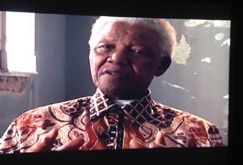Nelson Mandela
Mandela and Gandhi on the Hill
The hospital and letters
The room in the Old Fort that was used as the hospital is about the size of two small garages alongside one another. It has tall ceilings - almost four metres high - and a row of covered windows along its southern wall. Its wooden floor is well worn; its grey, patchy walls have not been painted for many years. Pictures of Mandela's cell on Robben Island are displayed, showing a neat and orderly space, with bookshelves, a desk and a bed. The famous National Geographic photograph of the naked, smiling Andamanese woman is on display at the exhibition. It had been framed for him by his fellow inmates, in particular Mac Maharaj, using carefully cut pieces of cardboard as a makeshift frame. On his release, National Geographic sent Mandela a copy of the original photograph. A stack of wooden boxes is a small sample of the 76 boxes that were used to hold the 76 000 pieces of correspondence between Mandela and the prison authorities. He frequently wrote letters on behalf of his fellow inmates protesting against the petty regulations of disallowing books to study, or complained about the quality of the food. One letter of complaint runs to 25 pages. Some of the letters were written in Afrikaans, an effort to appeal to the prison bosses whose mother tongue was Afrikaans. Large folio books meticulously record every letter written by and sent to Mandela. One of his letters, dated October 1989, just a few months before he was released, is displayed. It is written to his grandchild, and he signed it: "A million kisses and tons and tons of love, Grandpa." In a postscript he says he should have used "Darling" in the salutation instead of "Dear", saying he only thought of this when he was signing off the letter.Two videos
Two videos run constantly. The first one, filmed in April 1977, some 13 years into Mandela's life sentence on Robben Island, records an official visit in which the prison authorities invited the foreign press to visit the island, to see for themselves the conditions under which the prisoners were being held. It records several prisoners with spades, clearing weeds from a gravel path. At first Mandela is not visible - he was apparently hiding behind a bush - but then the camera zooms in on him. He stands impassively, his lips tight and unsmiling, staring ahead, bursting with anger. As soon as the visitors left, the long trousers were exchanged for short ones, and the men were given hammers again, to sit and crush rocks mindlessly. Mandela is wearing long khaki trousers and a shirt, with a small hat on his head. The issue of long versus short trousers was a cause of conflict between prisoners and prison authorities. Mature men like Mandela and others were at first given short trousers to wear, in an effort to humiliate them. Mandela fought this ruling vehemently and eventually won. The other video, from December 2003, shows Mandela arriving at the newly built Constitutional Court, built below the Old Fort, and being welcomed by the then chief justice of the court, Arthur Chaskalson. He is asked to sign a copy of the Bill of Rights, and is told about the signing of the three words, "Freedom, dignity and equality", by the judges in concrete above the court door. He is given a gift of a brick from the demolished Awaiting Trial Block, where he spent time.Gandhi exhibition
Constitution Hill has another permanent exhibition visitors can take in. The exhibition, entitled "Gandhi: prisoner of conscience", opened in October 2006, off the courtyard of No 4 prison, in the former visitors' centre. Gandhi formulated and refined his Satyagraha or passive resistance philosophy while living and working in Joburg. The exhibition focuses on the years he spent in Johannesburg, from 1902 until 1914, when he left South Africa at the age of 46. During this time, he was transformed from a shy lawyer into an extraordinary leader of international stature. The exhibition details the experiences that shaped his development by means of photographs, quotes, artefacts and audio material. Gandhi's transformation is symbolised in the changes in his attire - from a besuited lawyer to rough prison garb to a simple cotton tunic on his departure for India in 1914. Gandhi said of his experiences in South Africa: "Truly speaking, it was after I went to South Africa that I became what I am now. My love for South Africa and my concern for her problems are no less than for India." Mandela is quoted on the walls of the exhibition as saying: "The spirit of Gandhi may well be a key to human survival in the 21st century." Two great 20th century fighters for the rights of the oppressed - a good reason to visit Constitution Hill. Source: City of Johannesburg
Video of Nelson Mandela arriving at the newly built Constitutional Court in December 2003 (Photo: Lucille Davie, City of Johannesburg)




